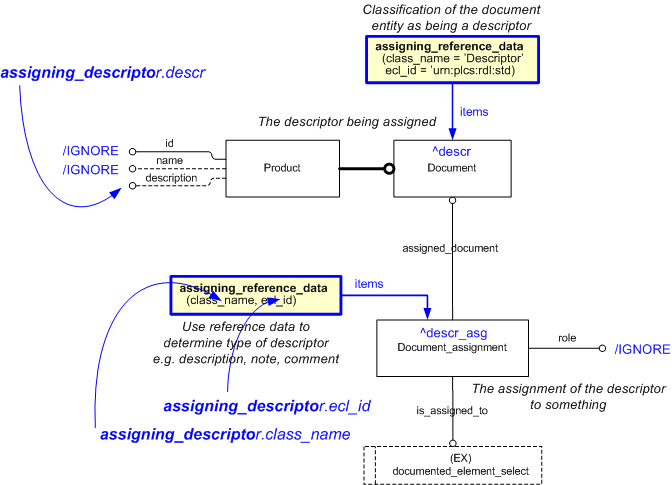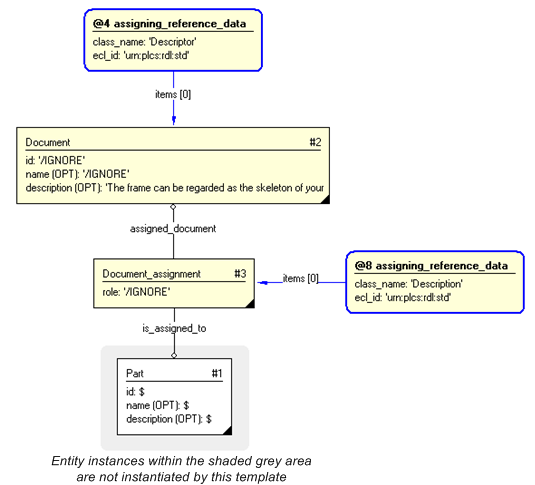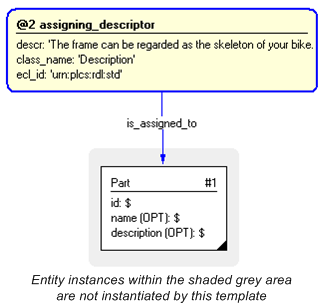Template:— assigning_descriptor (asg_descr)
Capability:assigning_descriptor |
Date: 2008/03/08 14:52:57
Revision: 1.17
|
This section specifies the template assigning_descriptor.
NOTE
The template has been defined in the context of the capability
assigning_descriptor
which provides an overall description of the
relevant parts of the ISO 10303-239 information model and a description
of related templates.
NOTE
An explanation of a template and the associated instantiation path is
provided in the
Template overview
section.
This template describes the assignment of descriptors to entities within a data set.
The meaning of the assignment is provided by classification. The template
excludes the usage of defined characterizations.
NOTE
A descriptor is a generic term for textual descriptions, remarks, notes etc.
The EXPRESS-G diagram in
Figure
1
shows the templates and EXPRESS entities that are required
to represent the template
"assigning_descriptor".
The text highlighted in blue shows the template parameters.
Figure 1 — Attribute values set by the template 'assigning_descriptor'.
The graphic for the template to be used in other EXPRESS-G diagrams
is shown in Figure
2
below.
Figure 2 — Graphical representations of the template 'assigning_descriptor'.
The following input parameters are defined for this template:
The text being assigned as a descriptor.
The name of the class
(
External_class)
being used to determine type of descriptor.
The following classes and their sub-classes can be used:
ecl_id (Default=urn:plcs:rdl:std,Type='URN')
The following reference parameters are defined for this template:
Allow the
Document_assignment
entity instantiated in this path to be referenced when this template is used.
%^target = $assigning_descriptor.descr_asg%
Allow the
Document
entity instantiated in this path to be referenced when this template is used.
Note: The
Document
entity can be referenced in a template path by:
%^target = $assigning_descriptor.descr%
where
target
is the parameter to which the
Document
is bound.
The instantiation path shown below specifies the entities that are to be
instantiated by the template.
A description of templates and the syntax for the instantiation path is
provided in the
Templates Help/Information section.
The following entities are instantiated with attributes as specified:
The instance diagram in Figure
3
shows an example of the EXPRESS entities and templates that are instantiated by the template:
/assigning_descriptor(items='#1', descr='The frame can be regarded as the skeleton of your bike. It structural design is such that it can withstand a
great deal of stress.', class_name='Description', ecl_id='urn:plcs:rdl:std')/
(an illustration of the consolidated assigning_descriptor template is shown in
Figure
4 below.)
Note that two instances of the template
assigning_reference_data
are used in the diagram.
Namely:
@4 /assigning_reference_data(items='#2', class_name='Descriptor', ecl_id='urn:plcs:rdl:std')/
and
@8 /assigning_reference_data(items='#3', class_name='Description', ecl_id='urn:plcs:rdl:std')/
Figure 3 — Instance diagram instantiated by the template example
The instance diagram in
Figure
4
shows the graphic symbol for the template that is to be
used in other instance diagrams. The example template is:
/assigning_descriptor(items='#1', descr='The frame can be regarded as the skeleton of your bike. It structural design is such that it can withstand a
great deal of stress.', class_name='Description', ecl_id='urn:plcs:rdl:std')/
Figure 4 — Invocation of template - graphical presentation
The following section details how the
assigning_descriptor
template can be optionally characterized by assigning
other constructs to it. These are characterizations commonly
applied to the template. The ISO 10303-239 EXPRESS model may enable
other assignments to the entities instantiated by the template.
The EXPRESS-G diagram in Figure
5
shows the possible characterizations of the template
"assigning_descriptor".
Figure 5 — Examples of optional characterizations of a descriptor
The following characterizations may apply:
Characterization Assigning date time
NOTE this characterization is optional.
Dates may be associated with the assignment of a descriptor (reference parameter ^descr_asg) by
using the template
assigning_time.
For example, the date and time when a descriptor was assigned may enable simple version management.
Characterization Assigning organization
NOTE this characterization is optional.
Organizations may be associated with the assignment of a descriptor (reference parameter ^descr_asg) by
using the template
assigning_organization.
This enables multiple descriptors to assigned to the same object, but from different perspectives.





